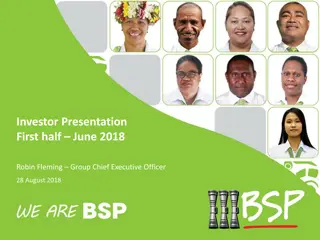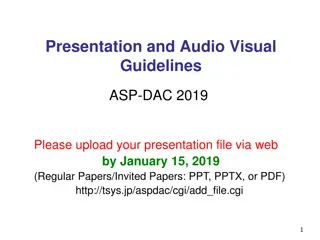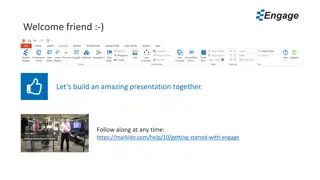Benefits Data Trust - Improving Access to Essential Benefits
Benefits Data Trust (BDT) is a national nonprofit using data, technology, and policy to provide efficient access to assistance, enhancing health and financial security. Their vision includes connecting people to essential benefits with dignity and respect, aiming for lower healthcare costs and thriving communities. BDT addresses the problem of unclaimed benefits and highlights the impact of programs like SNAP and WIC on improving outcomes. They work towards a world where individuals have access to vital services, leading to healthier and economically stable lives.
- Benefits Data Trust
- Nonprofit Organization
- Access to Benefits
- Data Technology
- Health and Financial Security
Download Presentation

Please find below an Image/Link to download the presentation.
The content on the website is provided AS IS for your information and personal use only. It may not be sold, licensed, or shared on other websites without obtaining consent from the author. Download presentation by click this link. If you encounter any issues during the download, it is possible that the publisher has removed the file from their server.
E N D
Presentation Transcript
Benefits Data Trust Helping people today, modernizing benefits access for tomorrow Jillian Humphries, Policy Manager February 7, 2023
Hunger Free Communities Presentation 1 2 3 4 BDT: who we are and what we do WIC Toolkit DSA Playbook SNAP-Medicaid Coordination Survey 2
About BDT Benefits Data Trust (BDT) is a national nonprofit harnessing the power of data, technology, and policy to provide efficient and dignified access to assistance, improving people's health and financial security. 3
BDT Vision We envision a world that connects people to essential benefits and services while treating them with dignity and respect. Lower healthcare costs, more efficient government, and people who are healthy, economically mobile, and thriving. 4
The Problem $80 billion in benefits left on the table each year 1 More than 1 in 10 Americans living in poverty 2 More than 9 million people missing out on benefits 3 Sources: 1: BDT estimate based on publicly available data for WIC, SNAP, Medicaid, CHIP, EITC, and Pell Grants 2: "Income and Poverty in the United States: 2019." United States Census Bureau 3: BDT estimate based on publicly available data on benefit participation gaps 5
Why Benefits Matter: Improved Outcomes SNAPsaves $1,400/year per adult in healthcare costs1, improves children's reading & math scores, increases high school graduation rates2 SNAP for adults 65+: saves over $2,100 per person3 reduces the likelihood of hospitalization by 14%3 reduces nursing home utilization by 23%3 WIC improves immunization rates among children4 Medicaiddecreases mortality5 and increases high school, college completion6 Sources: 1: Supplemental Nutrition Assistance Program (SNAP) Participation and Health Care Expenditures Among Low-Income Adults. S. Berkowitz et al. 2: Food Stamp Program Participation Is Associated with Better Academic Learning among School Children. E. Frongilloet al. 3: Seniors and SNAP: Reducing Hunger and Improving Outcomes. Benefits Data Trust. 4: The Impact of WIC on Infant Immunizationsand Health Care Utilization. T. Bersak & L. Sonchak. 5: Health Insurance and Mortality: Experimental Evidence from Taxpayer Outreach. J. Goldin, I. Lurie & J. McCubbin. 6: The Effect of Child Health Insurance Access on Schooling: Evidence from Public Insurance Expansions. S. Cohodeset al. 6
Barriers to Access Lack of knowledge Cumbersome applications Limited mobility Stigma May not have technology 7
BDTs Strategies to Deliver Impact Data Analytics & Technology Direct Service Data-driven outreach & assistance Customized software Tech-enabled assistance Serving people in ways that work best for them Screening for multiple benefits Individualized outreach & engagement Dignified service at scale Our multi-pronged, person- centered approach improves health & economic mobility Policy & Practice Solutions Partner Engagement Philanthropy Local, state, & federal government National organizations Community-based organizations Healthcare plans & providers Academia Policy & process change to streamline access Cross-sector data sharing Outcomes-focused research 8
Our Impact 143k+ inbound calls 62K+ enrollments Statistics for 2020 $2,892 benefits per household 36K+ referrals to community partners 93K+ applications submitted Since 2005 > 1 million applications submitted $7.5 billion+ benefits delivered 9
Where We Work Policy and Practice Assistance to States* Enrollment Assistance to Individuals + Policy and Practice Assistance to States* *This map reflects BDT s work in 2020 10
Toolkit: Increasing WIC Coverage Through Cross-Program Data Matching and Targeted Outreach In recent years, more than 40 percent of eligible individuals have missed out on the Special Supplemental Nutrition Program for Women, Infants, and Children (WIC), despite the program s well-documented dietary, health, and developmental benefits. Many of those missing out on WIC are enrolled in Medicaid or the Supplemental Nutrition Assistance Program (SNAP) which makes them automatically income-eligible, or adjunctively eligible, for WIC. This toolkit is designed to help state and local WIC agencies leverage data from Medicaid and SNAP to measure enrollment gaps and increase enrollment using tools to plan, launch, and/or strengthen data matching and targeted outreach to eligible families who are not receiving WIC benefits. 11
Toolkit: Increasing WIC Coverage Through Cross-Program Data Matching and Targeted Outreach Completing this toolkit will help your team: Set project goals for increasing WIC participation and enrolling a greater share of adjunctively eligible families; Develop a comprehensive workplan for launching a data matching and targeted outreach initiative; Plan an evaluation that measures progress toward goals and can guide improvements over time; and Benefit from lessons learned in states that have matched Medicaid or SNAP data with WIC data to measure the enrollment gap and conduct targeted outreach. Additional Resources Using Data Matching and Targeted Outreach to Enroll Families With Young Children in WIC: Lessons Learned From State PilotsOpens in a new windowBenefits Data Trust and Center on Budget and Policy Priorities, January 5, 2021. Outreach Landscape ExamplesOpens in a new windowThis resource provides descriptions of outreach in two states. Examples published in Targeted Text Message Outreach Can Increase WIC Enrollment, Pilots ShowOpens in a new window, Benefits Data Trust and Center on Budget and Policy Priorities, June 10, 2021. Learn more about the WIC toolkit at https://bdtrust.org/wic-toolkit-22/ 12
DSA Playbook Benefits Data Trust (BDT) is thrilled to announce the release of Data Sharing to Build Effective and Efficient Benefits Systems: A Playbook for State and Local Agencies. This resource is designed to support administering government agencies and other sectors like health care, higher education, and research entities scope and implement successful data sharing projects, with legal considerations in mind. Learn more and download this playbook at https://bdtrust.org/bolstering-benefits- access-introducing-benefits-data-trust%E2%80%99s-new-data-sharing-playbook/ Also, BDT recently hosted a webinar featuring government officials who are leading impactful and innovative data sharing efforts. If you missed the webinar, you can still view the recording on this page. 13
SNAP Medicaid Data Coordination In 2022, BDT, with support from the Robert Wood Johnson Foundation, and in collaboration with the Center for Health Care Strategies, conducted a nationwide review of how SNAP and Medicaid programs within each state coordinate and share data. There were three key findings from the survey: 1. Integration is not necessary for data sharing across programs states without integrated SNAP and Medicaid systems share data at almost the same rate as those with integrated systems. 2. States commonly share SNAP and Medicaid data with third parties; most often with Managed Care Organizations (MCOs) and non-profits. 3. Medicaid and SNAP data sharing occurs in states across the political spectrum, regardless of state size or region. 14
SNAP Medicaid Data Coordination WHAT S NEXT With this work, BDT and the Center for Health Care Strategies aim to improve access to services by providing actionable recommendations, tools, and technical assistance to individual state agencies navigating data-coordination issues. Throughout this two-year project, we will disseminate case studies, additional reports, and other announcements. Download the first report and look for more to come at https://bdtrust.org/bridging- gaps-in-benefits-access-how-data-coordination-can-bolster-enrollment-across- programs/ 15























